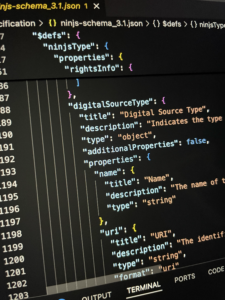Categories
Archives

The IPTC is excited to announce the latest updates to ninjs, our JSON-based standard for representing news content metadata. Version 3.1 is now available, along with updated versions 2.2 and 1.6 for those using earlier schemas.
These releases reflect IPTC’s ongoing commitment to supporting structured, machine-readable news content across a variety of technical and editorial workflows.
What is ninjs?
ninjs (News in JSON) is a flexible, developer-friendly format for describing news items in a structured way. It allows publishers, aggregators, and news tech providers to encode rich metadata about articles, images, videos, and more, using a clean JSON format that fits naturally into modern content pipelines.
What’s new in ninjs 3.1, 2.2 and 1.6?
The new releases add a new property for the IPTC Digital Source Type property, which was first used with the IPTC Photo Metadata Standard but now used across the industry to declare the source of media content, including content generated or manipulated by a Generative AI engine.
The new property (called digitalSourceType in 3.1 and digitalsourcetype in 2.2 and 1.6 to match the case conventions of each standard version) has the following properties:
- Name: the name of the digital source type, such as “Created using Generative AI”
- URI: the official identifier of the digital source type from the IPTC Digital Source Type vocabulary or another vocabulary, such as http://cv.iptc.org/newscodes/digitalsourcetype/trainedAlgorithmicMedia (the official ID for generative AI content)
- Literal: an optional way to add new digital source types that are not part of a controlled vocabulary.
IPTC supports multiple versions of ninjs in parallel to ensure stability and continuity for publishers and platforms that depend on long-term schema support.
The new property is part of the general ninjs schema, and so can be used in the main body of a ninjs object to describe the main news item and can also be used in an “association” object which refers to an associated media item.
Access the schemas
All versions are publicly available on the IPTC website:
ninjs generator and user guide
The ninjs Generator tool has been updated to cover the latest versions. Fill in the form fields and see what that content looks like in ninjs format. You can switch between the schema versions to see how the schema changes between 1.6, 2.2 and 3.1.
The ninjs User Guide has also been updated to reflect the newly added property.
Why it matters
As the news industry becomes increasingly reliant on metadata for content distribution, discoverability, and rights management, ninjs provides a modern, extensible foundation that supports both human and machine workflows. It’s trusted by major news agencies, technology platforms, and AI developers alike.
Get involved
We welcome feedback from the community and encourage you to share how you’re using ninjs in your own products or platforms. If you would like to discuss ninjs, you can join the public mailing list at https://groups.io/g/iptc-ninjs.
If you’re interested in contributing to the development of IPTC standards, join us!

“As content becomes commoditised, there will be a trend towards authentic, human-created work,” said Scott Belsky at the 2025 Content Authenticity Summit, held last week on Roosevelt Island, New York.
Over 200 authenticity experts from over 150 companies joined together at the Cornell Tech campus in New York City on Wednesday 4th June to share the latest work of those implementing C2PA in the industry.
The theme of the event was real-world implementation of C2PA and spreading the word about Content Credentials, the user-facing brand of the C2PA technology.
The event was co-presented by IPTC along with the Content Authenticity Initiative (CAI) and the Coalition for Content Provenance and Authenticity (C2PA)
Highlights were:
- The launch of the C2PA Conformance programme, which will allow device and software implementers to be able to obtain certificates on the official C2PA Trust List (after the current Temporary Trust List is shut down later in 2025)
- A talk from Bruce MacCormack of CBC / Radio Canada, Chair of the IPTC Media Provenance Committee, on how the media industry is implementing C2PA, and the importance of publisher branding and organisational stamping of content at publish time to prevent brand hijacking and misattribution of news content
- An in-depth discussion of the IPTC Origin Verified News Publisher programme, including the launch of the IPTC guidance document helping news publishers to implement C2PA
- Another deep-dive workshop looking at which metadata fields should be included in C2PA-signed content. The discussion covered both metadata about the publisher and metadata about the content itself.
- Eight simultaneous tracks of breakout sessions covering device conformance, implementation in the news industry, real-world deployments on Amazon Web Services, work on standardisation with ISO and other bodies,
- A fast-paced and wide-ranging presentation from UC Berkeley professor Hany Farid on the importance of authenticity and the difficulty of keeping up with deepfake detection in our world of ever-improving generative AI models
- The many and varied discussions among attendees around their own effort to implement C2PA technology within their newsrooms
The most common feedback that we heard from attendees was that participants would have liked to be at all of the breakout sessions at the same time!
The event was held under the Chatham House Rule, which means that detailed recordings will not be available, although anonymised workshop summaries will soon be made available to attendees.
For more information about C2PA, the Media Provenance Committee or the Verified News Publisher List, please contact IPTC directly.
The IPTC has released a guide helping news organisations to sign their news content using C2PA technology.
The guidance was launched at today’s Content Authenticity Summit in New York, co-hosted by IPTC along with the Content Authenticity Initiative and the Coalition for Content Provenance and Authenticity (C2PA).
The guide walks publishers and broadcasters through the steps of evaluating and understanding why they should want to implement content provenance at their organisation, and what they aim to achieve. The guide suggests some use cases and reasons that media organisations might want to consider while planning their implementation.
Next, the guide walks through how publishers can obtain a certificate from one of our Certificate Authority partners; submitting the certificate to the Verified News Publisher list, and signing content using your publisher certificate.
The IPTC Media Provenance Committee will adapt the guide over the coming months as the procedure evolves.
For questions on the guidelines or for any other issues regarding the IPTC Origin Verified News Publishers List, please contact IPTC.
The International Press Telecommunications Council (IPTC) is proud to co-host the 2025 Content Authenticity Summit, along with the Coalition for Content Provenance and Authenticity (C2PA) and the Content Authenticity Initiative (CAI). The event will be held tomorrow, Wednesday 4 June at the Cornell University campus on Roosevelt Island, New York City.
The Content Authenticity Summit will convene over 200 of the world’s foremost experts on digital content provenance including implementers, creators, and policymakers for a one-day series of presentations, panels, breakout sessions, and hands-on demonstrations to highlight the latest developments in this essential and fast-moving space.
The Summit, presented by the Content Authenticity Initiative, the Coalition for Content Provenance and Authenticity, and the International Press Telecommunications Council, will highlight current opportunities and challenges focused on driving broad awareness and adoption of Content Credentials.

Brendan Quinn, Managing Director of IPTC, will be hosting two workshops at the Content Authenticity Summit.
Many other IPTC members will also be represented:
- Adobe will have many representatives at the event, including Andy Parsons, Eric Scouten, Pia Blumenthal and Leonard Rosenthol
- Bruce MacCormack of CBC / Radio Canada, Chair of the Media Provenance Committee, will speak about C2PA adoption in the news media
- Helge O. Svela, CEO of Media Cluster Norway will co-host workshops on C2PA in the news industry.
- AFP and IMATAG will present a case study on their project to digitally sign content
- Charlie Halford of the BBC will co-host the workshop on C2PA metadata in the news industry
- Will Kreth of HAND Identity will be speaking about how provenance protects the identities of athletes and entertainers
- Sherif Hanna of Google will be speaking about the forthcoming C2PA Conformance process.
Other speakers include representatives from Meta, LinkedIn, OpenAI, Partnership on AI and Nikon.
We will report on the event later this week. If you’re attending, come and say hello to our members and to IPTC Managing Director Brendan Quinn.
Categories
Archives
- December 2025
- November 2025
- October 2025
- September 2025
- August 2025
- July 2025
- June 2025
- May 2025
- April 2025
- March 2025
- February 2025
- January 2025
- December 2024
- November 2024
- October 2024
- September 2024
- August 2024
- July 2024
- June 2024
- May 2024
- April 2024
- March 2024
- February 2024
- December 2023
- November 2023
- October 2023
- September 2023
- August 2023
- July 2023
- June 2023
- May 2023
- March 2023
- February 2023
- January 2023
- December 2022
- November 2022
- October 2022
- September 2022
- August 2022
- July 2022
- June 2022
- May 2022
- April 2022
- March 2022
- February 2022
- January 2022
- December 2021
- November 2021
- October 2021
- September 2021
- August 2021
- July 2021
- June 2021
- May 2021
- April 2021
- February 2021
- December 2020
- November 2020
- October 2020
- September 2020
- August 2020
- July 2020
- June 2020
- May 2020
- April 2020
- March 2020
- February 2020
- December 2019
- November 2019
- October 2019
- September 2019
- July 2019
- June 2019
- May 2019
- April 2019
- February 2019
- November 2018
- October 2018
- September 2018
- August 2018
- July 2018
- June 2018
- May 2018
- April 2018
- March 2018
- January 2018
- November 2017
- October 2017
- September 2017
- August 2017
- June 2017
- May 2017
- April 2017
- December 2016
- November 2016
- October 2016
- September 2016
- August 2016
- July 2016
- June 2016
- May 2016
- April 2016
- February 2016
- January 2016
- December 2015
- November 2015
- October 2015
- September 2015
- June 2015
- April 2015
- March 2015
- February 2015
- November 2014

